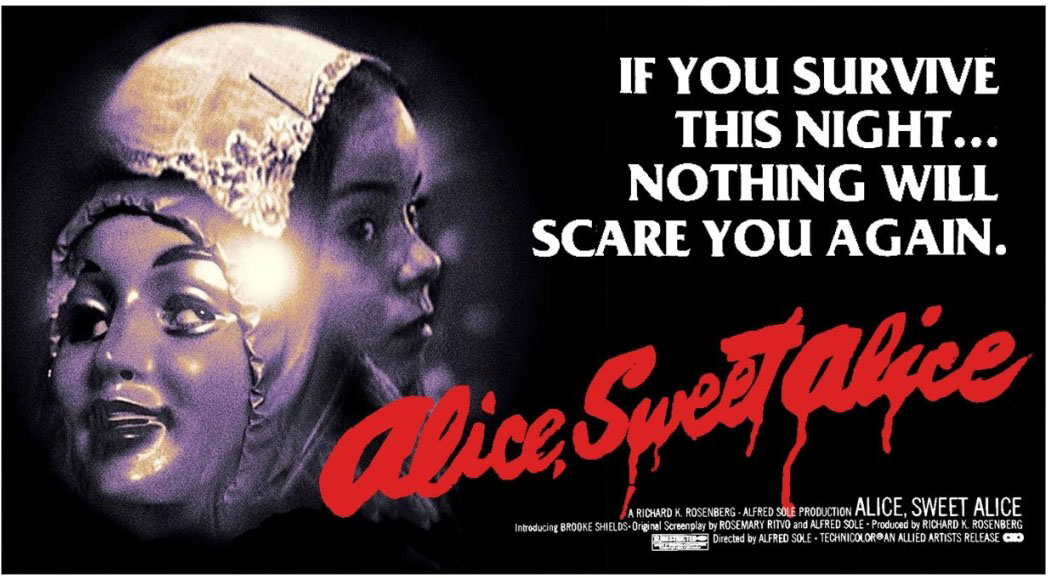aka Communion, aka Holy Terror
Alice, Sweet Alice begins with a vicious case of sibling rivalry and explodes into a critique of all levels of family ties — drenched in Roman Catholic ideology, iconography and guilt. It was the director, Alfred Sole’s first non-pornographic feature and he indulged a tendency towards quite brutal onscreen violence like he knew this would be his last chance. While it’s often overlooked in lists of the best 1970s horror movies, Alice, Sweet Alice rewards deeper examination. It has a lot going for it apart from Brooke Shields: the production design captures the intimate, often shabby details of New Jersey Catholicism and Rosemary Ritvo’s screenplay embraces the sheer ugliness of dealing with a death within the family that isn’t really equalled until 2018’s Hereditary.
The Movie
A young Brooke Shields plays 10 year-old Karen, the ‘good sister’, preparing for her First Communion under the jealous gaze of her older, stranger sister 12 year-old Alice (Paula Sheppard). Alice, already earmarked as a “troubled” child by the Mother Superior at her Catholic school, lashes out spitefully at her younger sibling, stealing her favorite doll, tampering with her communion veil, and luring her into an abandoned building where (in a classic startle moment) she terrifies Karen and tells her that worse is to come if she ever tells.
Worse is indeed in store for poor Karen. While her mother (Linda Miller) and Aunt Annie (Jane Lowry) admire the line of white-veiled girls receiving the sacrament for the first time, she is rudely attacked by a masked, yellow-raincoated killer at the First Communion service, strangled, dumped inside a wooden box bench, and set on fire. Her smoldering corpse is discovered by a nun curious about the source of the smoke drifting through the church. Cue mass hysteria in the congregation, and Alice’s presence at the altar, wearing Karen’s veil (which she claims to have found on the floor) and demanding Communion out of turn, is a cause of concern for her mother and aunt.
A spate of vicious killings ensues, with Alice apparently at the epicenter — a masked, yellow-raincoated killer is seen committing every crime. Everyone, from psychiatrists to police to Aunt Annie seems to believe that this sullen little girl is capable of brutal murder. Only her mother, Catherine, speaks in her defence, despite her oft-expressed exasperation with her first-born.
Alice’s sociopathic behavior is attributed to a range of causes, the usual suspects where teenage misdemeanors are concerned. Her parents are divorced, her father remarried, despite the family’s entrenched Catholicism. Mom still feels guilty about sex before marriage (leading to her pregnancy with Alice), which may explain her conflicted attitude towards her oldest child. Mom’s relationship with her own sister is volatile, especially when Annie starts hurling accusations about her being a shoddy Catholic (and, by implication, a bad mother). It’s easy to see where Alice has learned her hostility.
Then, there’s puberty, which seems to be hitting Alice early and hard. The man who administers a polygraph test to Alice comments to the detective “Did you see her tits?” We witness Alice wriggling free from the clutches of her creepy, obese, cat-hoarding neighbor, Mr. Alphonso (Alphonso DeNoble), but there’s no telling how many times he’s pawed her before. The examining psychiatrist, Dr. Whitman (Louisa Horton) discovers that Alice has begun menstruating but hasn’t informed her mother of the fact. Alice may only be twelve years old, but other people are afraid of her, and the movie narrative exploits that fear. She’s around the same age as Regan in The Exorcist, on the same proverbial ‘cusp of womanhood’ and with the same power to disturb her mother and the Catholic authorities, along with the audience. Alice could also be Carrie’s little sister — Brian De Palma’s movie was released the same year to much greater fanfare.
Ultimately, Alice, Sweet Alice steers clear of any supernatural shenanigans (other than those embodied in the Catholic rituals that form a backdrop to so many key scenes). Instead, it focuses on the disruptive powers of a barely-teenage girl, who manages to fracture seemingly inviolable institutions such as church and family with alarming ease. Alice is simply a sign of the times. Paula Sheppard (who was 19 at the time of filming) captures the nuances of the aggrieved and misunderstood Alice, maintaining her surly disposition —and, along with it, lingering doubts about what she might be capable of — until the final frame. The Brazilian director, Alfred Sole, draws upon the vivid technicolor of gialli, in terms of both his visual palette and heightened emotional drama. The gruesome splatter effects were created by William Lustig, who would go on to attract a lot of controversy as the FX mastermind behind Maniac (1980). Gialli is also an influence on the lurid psychological elements of the narrative. The identity of the killer is revealed before the end of Act Two, leaving the narrative to reach closure with the “why” rather than the “who” of the mystery.
Spookier and more sophisticated than the average slasher flick, this underrated movie deserves a second look. It failed to gain much traction on initial release (in 1976, as Communion) but gained a wider audience a couple of years later after Brooke Shields hit big with Pretty Baby in 1978. Still, it’s never quite managed to garner the credit it deserves, nor has its influence ever been fully acknowledged. The “slash and dash” violence predates John Carpenter’s Halloween by a couple of years, and the ultimately atheist resolution offers an intriguingly schlocky counterpoint to The Exorcist.
